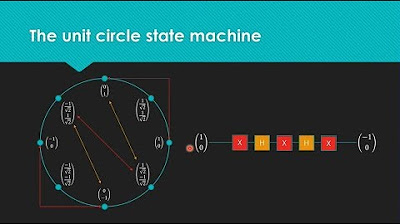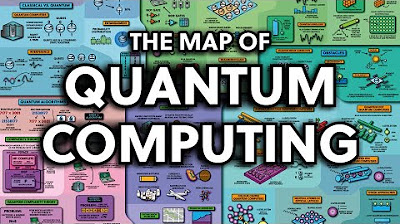What can my homemade quantum computer do?
TLDRThe video script details the process of creating a quantum computer and using it to solve a computational puzzle. The creator explains the limitations and potential of quantum computing, highlighting its superiority over classical computing in certain tasks, such as factoring prime numbers. The script walks through the construction of a one-cubic quantum computer and the implementation of the Deutser algorithm to determine whether a secret function is balanced or constant, using the unique capabilities of quantum mechanics like superposition and interference.
Takeaways
- 🌟 Quantum computers are not universally superior to classical computers; they excel in specific tasks like factoring prime numbers.
- 🤔 The Deutser Joe algorithm is a favorite for demonstrating quantum computing capabilities, as it highlights the unique advantages of quantum computation.
- 🧠 Quantum computers can solve problems that would be practically impossible for classical computers, given the right quantum algorithm.
- 🔍 The script explores the difficulty of creating a quantum algorithm and the challenges in encoding quantum functions.
- 🎯 The main problem addressed is determining whether a given function is balanced or constant, using a quantum computer in a single run.
- 🌀 The script explains the theoretical process of encoding different functions (F1, F2, F3, F4) and how they would interact with input light.
- 💡 The solution to the quantum riddle involves sending in light at a 45° angle and measuring the output at the same angle to determine the nature of the secret function.
- 📈 The script provides a hands-on example of quantum computation, showing the practical steps and considerations in setting up a quantum system.
- 🔬 Experimentation with wave plates and light filters is crucial for understanding how quantum states can be manipulated and measured.
- 📊 The script emphasizes the importance of reversible quantum processes and the technical challenges in implementing quantum algorithms.
- 🚀 Building a quantum computer and understanding its operation is a complex task that requires significant effort and appreciation for the underlying quantum mechanics.
Q & A
What is the main topic of the video?
-The main topic of the video is the demonstration and explanation of a quantum computer and its capabilities, specifically using the Deut Joer algorithm to solve a quantum riddle.
What did the creator realize about their quantum computer?
-The creator realized that their quantum computer seems to be working well enough to use for a computation that is surprisingly effective, despite their initial expectations.
What is the common misconception about quantum computers?
-The common misconception is that quantum computers are super super computers that can solve all the world's problems, but in reality, they are usually worse than normal computers in most situations, being harder to build and only excelling in specific algorithms.
What is the significance of factoring prime numbers in quantum computing?
-Factoring prime numbers is significant because it is a problem that takes a very long time on a regular computer, especially for large numbers, and is essential for encryption. Quantum computers, with the right algorithm, could potentially solve this problem much faster.
What is the Deut Joer algorithm?
-The Deut Joer algorithm is a quantum algorithm that demonstrates what quantum computers can do well. It is used to solve a problem where one must determine if a secret function is balanced or constant, using a quantum computer only once.
How does the Deut Joer algorithm solve the quantum riddle?
-The Deut Joer algorithm solves the quantum riddle by sending in a superposition of zero and one (plus light) and then measuring the output at a 45-degree angle. The pattern of light transmission or blockage at this angle determines whether the secret function is balanced or constant.
What are the four possible functions the Deut Joer algorithm can identify?
-The four possible functions are: F1, which does nothing to the inputs; F2, which flips the one bit; F3, which outputs zero for zero input and one for one input; and F4, which outputs one for both inputs.
Why is measuring the state in the zero or one basis not helpful in this case?
-Measuring the state in the zero or one basis is not helpful because it collapses the superposition to one of those states, losing the information about all possible inputs. Instead, a specific measurement at a 45-degree angle is required to extract the necessary information.
How does the video creator demonstrate the concept of quantum superposition?
-The video creator demonstrates quantum superposition by explaining that when a quantum computer calculates on a superposition of inputs, it processes all possible inputs simultaneously. However, upon measurement, the quantum state collapses to one of the possible outcomes, highlighting the need for clever combination of inputs to extract the desired information.
What is the practical application of the Deut Joer algorithm in the context of the video?
-The practical application of the Deut Joer algorithm in the video is to solve a quantum riddle, which serves as a teaching tool to help viewers understand the principles of quantum computing and how quantum algorithms can process information in ways that classical computers cannot.
How does the video address the difficulty of creating quantum algorithms?
-The video addresses the difficulty of creating quantum algorithms by explaining that while quantum computing may seem powerful due to its ability to process multiple inputs simultaneously, it is challenging to devise methods to combine these inputs in a way that yields the desired information upon measurement. The Deut Joer algorithm is an exception where such a method is possible.
Outlines
🤖 Quantum Computing Introduction
The speaker discusses their experience of building a quantum computer and its capabilities. They clarify that while quantum computers are not super computers, they can solve specific problems that are impractical for classical computers, such as factoring large prime numbers. The speaker expresses excitement about demonstrating a quantum computation using a simple quantum algorithm called the Deutser Joe algorithm, which is effective in teaching the unique capabilities of quantum computers.
🔍 The Deutser Joe Algorithm Problem
The speaker introduces the Deutser Joe algorithm problem, which involves determining the nature of a secret function based on a single query. The function could be one of four types: a do-nothing function, a swap function, or two constant functions. The challenge is to figure out if the function is balanced (half of the outputs are zero and half are one) or constant (all outputs are the same). The speaker explains that while this problem is impossible for classical computers to solve with only one query, quantum computers offer a potential solution.
💡 Quantum Version of the Puzzle
The speaker describes the process of creating a quantum version of the puzzle, where the input and output are represented by light. They explain the need for a fair computation for the quantum computer and discuss the technicalities of encoding the function using light polarization. The speaker also talks about the use of wave plates to manipulate the light and the challenges in detecting changes in the light's state.
🧠 Understanding Quantum Functions
The speaker delves into the theoretical aspect of quantum functions, explaining how to encode different functions (F1, F2, F3, and F4) using light polarization and wave plates. They describe the behavior of each function and how to determine if the secret function is balanced or constant by observing the light's behavior after passing through the quantum computer. The speaker also shares their experimental process and the insights gained from it.
🌟 Solving the Quantum Riddle
The speaker presents the solution to the quantum riddle using the Deutser Joe algorithm. They explain that by sending in a superposition of zero and one (45-degree light) and measuring the output at a 45-degree angle, one can determine whether the secret function is balanced or constant. The speaker emphasizes the importance of cleverly combining inputs in quantum computing to extract the desired information upon measurement.
🎲 The Quantum Computing Challenge
The speaker invites the audience to a game where they have to guess whether the secret function is balanced or constant based on a single measurement. They demonstrate the process by putting a filter at a 45-degree angle and observing the light's behavior. The speaker highlights the excitement of applying quantum computing to real-world problems and the challenge of understanding and utilizing quantum algorithms.
Mindmap
Keywords
💡Quantum Computer
💡Deutsch-Jozsa Algorithm
💡Factoring Prime Numbers
💡Superposition
💡Entanglement
💡Quantum Gates
💡Polarized Light
💡Wave Plate
💡Balanced Function
💡Constant Function
Highlights
The speaker has created a quantum computer and is exploring its capabilities.
Quantum computers are not universally superior to classical computers; they excel in specific situations.
The classic example of quantum computing's advantage is factoring prime numbers, which is a hard problem for classical computers but could be solved more efficiently on a quantum computer.
A new polynomial-time quantum algorithm has been discovered, which may have significant implications.
The Deut Joer algorithm is used to demonstrate quantum computing's unique capabilities.
The Deut Joer algorithm helps to identify whether a secret function is balanced or constant, a problem that is difficult for classical computers but solvable with a quantum computer in one use.
The speaker's quantum computer is a one-cubic quantum computer, which is rudimentary but sufficient for demonstrating the Deut Joer algorithm.
The process of making a quantum algorithm work effectively is challenging and requires clever encoding of functions.
The speaker discusses the theoretical approach to encoding different functions for quantum computation using light polarization.
The experiment involves using a wave plate to manipulate light in a way that encodes the secret function for the quantum computer.
The speaker's confusion about the wave plate's function leads to an experimental approach to determine its effect.
The full wave plate is identified as the component that flips light, which is essential for encoding the function F4.
The speaker realizes that the wave plate may not be detectable with a simple filter due to the nature of quantum changes in light.
The design of the functions F1, F2, and F3 is explained through the manipulation of light polarization and filtering.
The speaker successfully constructs the quantum riddle solver using the Deut Joer algorithm and a 45-degree filter orientation.
The quantum riddle solver can determine if a secret function is balanced or constant based on a single measurement of light after it passes through the quantum box.
The experiment demonstrates the practical application of quantum computing principles in solving a specific problem.
Transcripts
Browse More Related Video

Quantum Computing for Computer Scientists

Quantum Computers, Explained With Quantum Physics

How Quantum Computers Break Encryption | Shor's Algorithm Explained

How Does a Quantum Computer Work?

The Map of Quantum Computing - Quantum Computing Explained

Quantum Computing Expert Explains One Concept in 5 Levels of Difficulty | WIRED
5.0 / 5 (0 votes)
Thanks for rating: